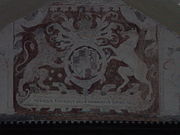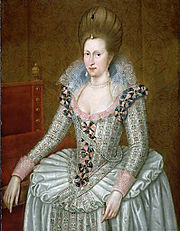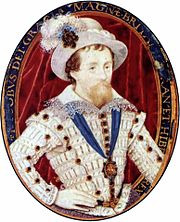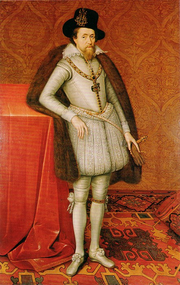
James VI and I
About this schools Wikipedia selection
SOS Children produced this website for schools as well as this video website about Africa. Visit the SOS Children website at http://www.soschildren.org/
| James VI and I | |
|---|---|
| King of Scotland, England, and Ireland | |
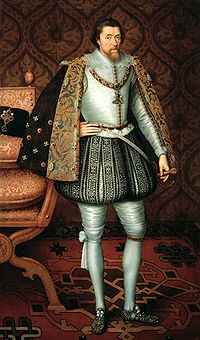 |
|
| James I of England from the period 1603–1613, by Paul van Somer I (1576–1621) | |
|
|
|
| Reign | 24 July 1567 – 27 March 1625 |
| Coronation | 29 July 1567 |
| Predecessor | Mary I |
| Successor | Charles I |
| Regent | James, Earl of Moray Matthew, Earl of Lennox John, Earl of Mar James, Earl of Morton |
|
|
|
| Reign | 24 March 1603 – 27 March 1625 |
| Coronation | 25 July 1603 |
| Predecessor | Elizabeth I |
| Successor | Charles I |
| Spouse | Anne of Denmark |
| Issue | |
| Henry Frederick, Prince of Wales Elizabeth, Queen of Bohemia Charles I Robert Stuart, Duke of Kintyre |
|
| Father | Henry Stuart, Lord Darnley |
| Mother | Mary, Queen of Scots |
| Burial | Westminster Abbey |
James VI and I (19 June 1566 – 27 March 1625) was King of Scotland as James VI, and King of England and King of Ireland as James I. He ruled in Scotland as James VI from 24 July 1567, when he was only one year old, succeeding his mother Mary, Queen of Scots. Regents governed during his minority, which ended officially in 1578, though he did not gain full control of his government until 1581. On 24 March 1603, as James I, he succeeded the last Tudor monarch of England and Ireland, Elizabeth I, who died without issue. He then ruled England, Scotland and Ireland for 22 years, often using the title King of Great Britain, until his death at the age of 58.
James achieved most of his aims in Scotland but faced great difficulties in England, including the Gunpowder Plot in 1605 and repeated conflicts with the English Parliament. According to a tradition originating with historians of the mid-seventeenth-century, James's taste for political absolutism, his financial irresponsibility, and his cultivation of unpopular favourites established the foundation for the English Civil War. Recent historians, however, have revised James's reputation and treated him as a serious and thoughtful monarch.
Under James, the "Golden Age" of Elizabethan literature and drama continued, with writers such as William Shakespeare, John Donne, Ben Jonson, and Sir Francis Bacon contributing to a flourishing literary culture. James himself was a talented scholar, the author of works such as Daemonologie (1597) and Basilikon Doron (1599). Sir Anthony Weldon claimed that James had been termed "the wisest fool in Christendom", an epithet associated with his character ever since.
Childhood
Birth
James Charles Stuart was the only child of Mary, Queen of Scots, and her second husband, Henry Stuart, Duke of Albany, commonly known as Lord Darnley. He was a descendant of Henry VII through his great-grandmother Margaret Tudor, elder sister of Henry VIII. Mary's rule over Scotland was insecure, for both she and her husband, being Roman Catholics, faced a rebellion by Protestant noblemen. Their marriage was a particularly difficult one. While Mary was pregnant with James, Lord Darnley secretly allied himself with the rebels and murdered the Queen's private secretary, David Rizzio.
James was born on 19 June 1566 at Edinburgh Castle, and as the eldest son of the monarch and heir-apparent, automatically became Duke of Rothesay and Prince and Great Steward of Scotland. Elizabeth I of England, as godmother in absentia, sent a magnificent gold font as a christening gift.
James's father Henry was murdered on 10 February 1567 at the Hamiltons' house, Kirk o' Field, Edinburgh, perhaps in revenge for Rizzio's death. Mary was already an unpopular queen, and her marriage on 15 May 1567 to James Hepburn, 4th Earl of Bothwell, who was widely suspected of murdering Henry, heightened widespread bad feeling towards her. In June 1567, Protestant rebels arrested Mary and imprisoned her in Loch Leven Castle; she never saw her son again. She was forced to abdicate on 24 July in favour of the infant James and to appoint her illegitimate half-brother, James Stewart, Earl of Moray, as regent.
Regencies
The care of James was entrusted to the Earl and Countess of Mar, "to be conserved, nursed, and upbrought" in the security of Stirling Castle. The boy was formally crowned at the age of thirteen months as King James VI of Scotland at the Church of the Holy Rude, Stirling, on 29 July 1567. The sermon was preached by the Geneva Calvinist John Knox. And, in accordance with the religious beliefs of most of the Scottish ruling class, James was brought up as a member of the Protestant national Church of Scotland, his education supervised by historian and poet George Buchanan, who subjected him to regular beatings but also instilled in him a lifelong passion for literature and learning.
In 1568, Mary escaped from prison, leading to a brief period of violence. The Earl of Moray defeated Mary's troops at the Battle of Langside, forcing her to flee to England, where she was subsequently imprisoned by Elizabeth. On 22 January 1570, Moray was assassinated by James Hamilton of Bothwellhaugh, to be succeeded as regent by James's paternal grandfather, Matthew Stewart, 4th Earl of Lennox, who a year later was carried fatally wounded into Stirling Castle after a raid by Mary's supporters. The next regent, John Erskine, 1st Earl of Mar, died soon after banqueting at the estate of James Douglas, 4th Earl of Morton, where he "took a vehement sickness", dying on 28 October 1572 at Stirling. Morton, who now took Mar's office, proved in many ways the most effective of James's regents, but he made enemies by his rapacity. He fell from favour when the Frenchman Esmé Stewart, Sieur d'Aubigny, first cousin of James's father Lord Darnley, and future Earl of Lennox, arrived in Scotland and quickly established himself as the first of James's powerful male favourites. Morton was executed on 2 June 1581, belatedly charged with complicity in Lord Darnley's murder. On 8 August, James made Lennox the only duke in Scotland. Then fifteen years old, the king was to remain under the influence of Lennox for about one more year.
Personal rule in Scotland
Although a Protestant convert, Lennox was distrusted by Scottish Calvinists, who noticed the physical displays of affection between favourite and king and alleged that Lennox "went about to draw the King to carnal lust". In August 1582, in what became known as the Ruthven Raid, the Protestant earls of Gowrie and Angus lured James into Ruthven Castle, imprisoned him, and forced Lennox to leave Scotland. After James was freed in June 1583, he assumed increasing control of his kingdom. He pushed through the Black Acts to assert royal authority over the Kirk and between 1584 and 1603 established effective royal government and relative peace among the lords, ably assisted by John Maitland of Thirlestane, who led the government until 1592. One last Scottish attempt against the king's person occurred in August 1600, when James was apparently assaulted by Alexander Ruthven, the Earl of Gowrie's younger brother, at Gowrie House, the seat of the Ruthvens. Since Ruthven was run through by James's page John Ramsay and the Earl of Gowrie was himself killed in the ensuing fracas, James's account of the circumstances, given the lack of witnesses and his history with the Ruthvens, was not universally believed.
In 1586, James signed the Treaty of Berwick with England. That and the execution of his mother in 1587, which he denounced as a "preposterous and strange procedure", helped clear the way for his succession south of the border. During the Spanish Armada crisis of 1588, he assured Elizabeth of his support as "your natural son and compatriot of your country", and as time passed and Elizabeth remained unmarried, securing the English succession became a cornerstone of James's policy.
Marriage
Throughout his youth, James was praised for his chastity, since he showed little interest in women; and after the loss of Lennox, he continued to prefer male company. A suitable marriage, however, was necessary to reinforce his monarchy, and the choice fell on the fourteen-year-old Anne of Denmark (born December 1574), younger daughter of the Protestant Frederick II. Shortly after a proxy marriage in August 1589, Anne sailed for Scotland but was forced by storms to the coast of Norway. On hearing the crossing had been abandoned, James, in what Willson calls "the one romantic episode of his life", sailed from Leith with a three-hundred-strong retinue to fetch Anne personally. The couple were married formally at the Old Bishop's Palace in Oslo on 23 November and, after stays at Elsinore and Copenhagen, returned to Scotland in May 1590. By all accounts, James was at first infatuated with Anne, and in the early years of their marriage seems always to have showed her patience and affection. But between 1593 and 1595, James was romantically linked with Anne Murray, later Lady Glamis, whom he addressed in verse as "my mistress and my love". The royal couple produced three surviving children: Henry, Prince of Wales, who was to die, probably of typhoid, in 1612, aged 18; Elizabeth, later Queen of Bohemia; and Charles, the future King Charles I of England. Anne predeceased her husband in March 1619.
Theory of monarchy
In 1597–1598, James wrote two works, The Trew Law of Free Monarchies and Basilikon Doron (Royal Gift), in which he established an ideological base for monarchy. In the Trew Law, he sets out the divine right of kings, explaining that for Biblical reasons kings are higher beings than other men, though "the highest bench is the sliddriest to sit upon". The document proposes an absolutist theory of monarchy, by which a king may impose new laws by royal prerogative but must also pay heed to tradition and to God, who would "stirre up such scourges as pleaseth him, for punishment of wicked kings". Basilikon Doron, written as a book of instruction for the four-year-old Prince Henry, provides a more practical guide to kingship. Despite banalities and sanctimonious advice, the work is well-written, perhaps the best example of James's prose. James's advice concerning parliaments, which he understood as merely the king's "head court", foreshadows his difficulties with the English Commons: "Hold no Parliaments," he tells Henry, "but for the necesitie of new Lawes, which would be but seldome". In the Trew Law James states that the king owns his realm as a feudal lord owns his fief, because:
"[Kings arose] before any estates or ranks of men, before any parliaments were holden, or laws made, and by them was the land distributed, which at first was wholly theirs. And so it follows of necessity that kings were the authors and makers of the laws, and not the laws of the kings."
English Throne
Proclaimed King of England
| Scottish and English Royalty |
|---|
| House of Stuart |
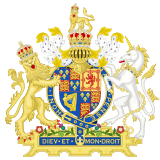 |
| James VI & I |
| Henry, Prince of Wales |
| Elizabeth, Queen of Bohemia |
| Charles I |
| Robert, Duke of Kintyre |
From 1601, in the last years of Elizabeth I's life, certain English politicians, notably her chief minister Sir Robert Cecil, maintained a secret correspondence with James in order to prepare in advance for a smooth succession. In March 1603, with the Queen clearly dying, Cecil sent James a draft proclamation of his accession to the English throne. Elizabeth died in the early hours of 24 March, and James was proclaimed king in London later the same day. As James headed south, his new subjects flocked to see him, relieved above all that the succession had triggered neither unrest nor invasion; When he entered London, he was mobbed. James's English coronation took place on 25 July, with elaborate allegories provided by dramatic poets such as Thomas Dekker and Ben Jonson, though an outbreak of the plague restricted festivities.
Early reign in England
Despite the smoothness of the succession and the warmth of his welcome, James survived two conspiracies in the first year of his reign, the Bye Plot and Main Plot, which led to the arrest, among others, of Lord Cobham and Sir Walter Raleigh. Those hoping for governmental change from James were at first disappointed when he maintained Elizabeth's Privy Councillors in office, as secretly planned with Cecil, but James shortly added long-time supporter Henry Howard and his nephew Thomas Howard to the Privy Council, as well as five Scottish nobles. In the early years of James's reign, the day-to-day running of the government was tightly managed by the shrewd Robert Cecil, later Earl of Salisbury, ably assisted by the experienced Thomas Egerton, whom James made Baron Ellesmere and Lord Chancellor, and by Thomas Sackville, soon Earl of Dorset, who continued as Lord Treasurer. As a consequence, James was free to concentrate on the bigger policies, such as a scheme for a closer union between England and Scotland and matters of foreign-policy, as well as to enjoy his leisure pursuits, particularly the hunt.
In 1604 he published A Counterblaste to Tobacco.
James was ambitious to build on the personal union of the crowns of Scotland and England to establish a permanent Union of the Crowns under one monarch, one parliament and one law, a plan which met opposition in both countries. "Hath He not made us all in one island," James told the English parliament, "compassed with one sea and of itself by nature indivisible?" In April 1604, however, the Commons refused on legal grounds his request to be titled "King of Great Britain". In October 1604, he assumed the title "King of Great Britain" by proclamation rather than statute, though Sir Francis Bacon told him he could not use the style in "any legal proceeding, instrument or assurance".
In foreign policy, James achieved more success. Never having been at war with Spain, he devoted his efforts to bringing the long Armada war to an end, and in August 1604, thanks to skilled diplomacy on the part of Robert Cecil and Henry Howard, now earl of Northampton, a peace treaty was signed between the countries, which James celebrated by hosting a great banquet. Freedom of worship for Catholics in England continued, however, to be a major objective of Spanish policy, causing constant dilemmas for James, distrusted abroad for repression of Catholics while at home being encouraged by the privy council to show even less tolerance towards them.
Gunpowder plot
On the eve of the state opening of the second session of James's first Parliament on 5 November 1605, a soldier named Guy Fawkes was discovered in the cellars of the parliament buildings guarding a pile of wood, not far from thirty-six barrels of gunpowder with which he intended to blow up Parliament House the following day and cause the destruction, as James put it, "not only...of my person, nor of my wife and posterity also, but of the whole body of the State in general". The sensational discovery of the Catholic Gunpowder Plot, as it quickly became known, aroused a mood of national relief at the delivery of the king and his sons which Salisbury exploited to extract higher subsidies from the ensuing Parliament than any but one granted to Elizabeth.
King and Parliament
The moment of co-operation between monarch and Parliament following the Gunpowder plot represented a deviation from the norm. Instead, it was the previous session of 1604 that shaped the attitudes of both sides for the rest of the reign, though the initial difficulties owed more to mutual incomprehension than conscious enmity. On 7 July 1604, James had angrily prorogued Parliament after failing to win its support either for full union of the crowns or financial subsidies. "I will not thank where I feel no thanks due," he had remarked in his closing speech. "...I am not of such a stock as to praise fools...You see how many things you did not well...I wish you would make use of your tolet liberty with more modesty in time to come".
As James's reign progressed, his government faced growing financial pressures, due partly to creeping inflation but also to the profligacy and financial incompetence of James's court. In February 1610 Salisbury, a believer in parliamentary participation in government, proposed a scheme, known as the Great Contract, whereby Parliament, in return for ten royal concessions, would grant a lump sum of £600,000 to pay off the king's debts plus an annual grant of £200,000. The ensuing prickly negotiations became so protracted that James eventually lost patience and dismissed Parliament on 31 December 1610. "Your greatest error," he told Salisbury, "hath been that ye ever expected to draw honey out of gall". The same pattern was repeated with the so-called " Addled Parliament" of 1614, which James dissolved after a mere eight weeks when Commons hesitated to grant him the money he required. James then ruled without parliament until 1621, employing officials such as the businessman Lionel Cranfield, who were astute at raising and saving money for the crown, and sold earldoms and other dignities, many created for the purpose, as an alternative source of income.
Spanish match
Another potential source of income was the prospect of a Spanish dowry from a marriage between Charles, Prince of Wales and the Spanish Infanta, Maria. The policy of the Spanish Match, as it was called, also attracted James as a way to maintain peace with Spain and avoid the additional costs of a war. The peace benefits of the policy could be maintained as effectively by keeping the negotiations alive as by consummating the match—which may explain why James protracted the negotiations for almost a decade. Supported by the Howards and other Catholic-leaning ministers and diplomats—together known as the Spanish Party—the policy was deeply distrusted in Protestant England.
The outbreak of the Thirty Years War, however, jeopardized James's peace policy, especially after his son-in-law, Frederick V, Elector Palatine, was ousted from Bohemia by Emperor Ferdinand II in 1620, and Spanish troops simultaneously invaded Frederick's Rhineland home territory. Matters came to a head when James finally called a parliament in 1621 to fund a military expedition in support of his son-in-law. The Commons on the one hand granted subsidies inadequate to finance serious military operations in aid of Frederick, and on the other—remembering the profits gained under Elizabeth by naval attacks on gold shipments from the New World—called for a war directly against Spain. In November 1621, led by Sir Edward Coke, they framed a petition asking not only for war with Spain but also for Prince Charles to marry a Protestant, and for enforcement of the anti-Catholic laws. James flatly told them not to interfere in matters of royal prerogative or they would risk punishment, which provoked them into issuing a statement protesting their rights, including freedom of speech. James ripped the protest out of the record book and dissolved Parliament once again.
In 1623, Prince Charles, now 23, and Buckingham decided to seize the initiative and travel to Spain incognito, to win the Infanta directly, but the mission proved a desperate mistake. The Infanta detested Charles, and the Spanish confronted them with terms that included his conversion to Catholicism and a one-year stay in Spain as, in essence, a diplomatic hostage. The prince and duke returned to England in October without the Infanta and immediately renounced the treaty, much to the delight of the British people. Their eyes opened by the visit to Spain, Charles and Buckingham now turned James’s Spanish policy upon its head and called for a French match and a war against the Habsburg empire. To raise the necessary finance, they prevailed upon James to call another Parliament, which met in February 1623. For once, the outpouring of anti-Catholic sentiment in the Commons was echoed in court, where control of policy was shifting from James to Charles and Buckingham, who pressured the king to declare war and engineered the impeachment of the Lord Treasurer, Cranfield, Earl of Middlesex, when he opposed the plan on grounds of cost. The outcome of the Parliament of 1624 was ambiguous: James still refused to declare war, but Charles believed the Commons had committed themselves to financing a war against Spain, a stance which was to contribute to his problems with Parliament in his own reign.
Religious challenges
The Gunpowder Plot reinforced James's oppression of non-conforming English Catholics; and he sanctioned harsh measures for controlling them. In May 1606, Parliament passed an act which would require every citizen to take an Oath of Allegiance, incorporating a denial of the Pope's authority over the king. James was conciliatory towards Catholics who took the Oath of Allegiance, and he tolerated crypto-Catholicism even at court. However, in practice he enacted even harsher measures against Catholics than were laid upon them by Elizabeth. Towards the Puritan clergy, with whom he debated at the Hampton Court Conference of 1604, James was at first strict in enforcing conformity, inducing a sense of persecution amongst many Puritans; but ejections and suspensions from livings became fewer as the reign wore on. A notable success of the Hampton Court Conference was the commissioning of a new translation and compilation of approved books of the Bible to confirm the divine right of kings to rule and to maintain the social hierarchy, completed in 1611, which became known as the King James Bible, considered a masterpiece of Jacobean prose. In Scotland, James attempted to bring the Scottish kirk "so neir as can be" to the English church and reestablish the episcopacy, a policy which met with strong opposition. In 1618, James's bishops forced his Five Articles of Perth through a General Assembly; but the rulings were widely resisted. James was to leave the church in Scotland divided at his death, a source of future problems for his son.
Favourites
Salisbury died in 1612, little mourned by those who jostled to fill the power vacuum. Until Salisbury's death, the Elizabethan administrative system over which he had presided continued to function with relative efficiency; from this time forward, however, James's government entered a period of decline and disrepute. Salisbury's passing gave James the notion of governing in person as his own chief Minister of State, with his young Scottish favourite, Robert Carr, Viscount Rochester, carrying out many of Salisbury's former duties, but James's inability to attend closely to official business exposed the government to factionalism.
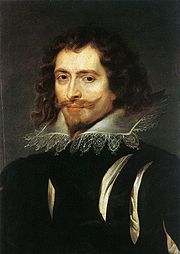
The Howard party, consisting of Northampton, Suffolk, Suffolk's son-in-law Lord Knollys, and Charles Howard, earl of Nottingham, along with Sir Thomas Lake, soon took control of much of the government and its patronage. Even the powerful Carr, unfitted for the responsibilities thrust upon him and often dependent on his intimate friend Sir Thomas Overbury for assistance with government papers, fell into the Howard camp, after beginning an affair with the married Frances Howard, countess of Essex, daughter of the earl of Suffolk, whom James assisted in securing an annulment of her marriage to free her to marry Carr. In summer 1615, however, it emerged that Sir Thomas Overbury, who on 14 September 1613 had died in the Tower of London, where he had been placed at the king's request, had been poisoned. Among those convicted of the murder were Frances Howard and Robert Carr, the latter having been replaced as the king's favourite in the meantime by a young man called George Villiers. The implication of the king in such a scandal provoked much public and literary conjecture and irreparably tarnished James's court with an image of corruption and depravity. The subsequent downfall of the Howards left George Villiers, now earl of Buckingham, unchallenged as the supreme figure in the government by 1618.
Personal relationships
Throughout his life James had close friendships with male courtiers, in particular Esmé Stewart, 6th Lord d'Aubigny (later 1st Duke of Lennox); Robert Carr, 1st Earl of Somerset; and George Villiers, 1st Duke of Buckingham. There has been debate among historians about the nature of these relationships: "The evidence of his correspondence and contemporary accounts have led some historians to conclude that the king was homosexual or bisexual. In fact, the issue is murky." (Bucholz, 2004) In Basilikon Doron, James lists sodomy among crimes "ye are bound in conscience never to forgive". At age twenty-three, James and three hundred of his men performed a dramatic rescue of Anne of Denmark when she was stranded on the coast of Norway. They married and bore seven children, some sources say nine children, only three of whom survived. James also had a documented two year affair with Anne Murray, later Lady Glamis, to whom he wrote poetry. However, restoration of Apethorpe Hall, undertaken 2004-2008, revealed a previously unknown passage linking the bedchambers of James and his favourite, George Villiers.
Final year
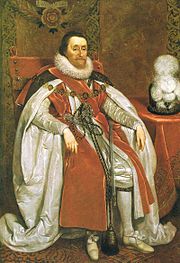
During the last year of James's life, with Buckingham consolidating his control of Charles to ensure his own future, the king was often seriously ill, leaving him an increasingly peripheral figure, rarely able to visit London. In early 1625, James was plagued by severe attacks of arthritis, gout and fainting fits, and in March fell seriously ill with tertian ague and then suffered a stroke. James finally died at Theobalds House on 27 March during a violent attack of dysentery, with Buckingham at his bedside. James’s funeral, a magnificent but disorderly affair, took place on 7 May. Bishop John Williams of Lincoln preached the sermon, observing, "King Solomon died in Peace, when he had lived about sixty years...and so you know did King James".
Legacy
The king was widely mourned. For all his flaws, James had never completely lost the affection of his people, who had enjoyed uninterrupted peace and comparatively low taxation during the Jacobean era. "As he lived in peace," remarked the Earl of Kellie, "so did he die in peace, and I pray God our king [Charles] may follow him". The earl prayed in vain: once in power, Charles and Buckingham sanctioned a series of reckless military expeditions that ended in humiliating failure. James bequeathed Charles a fatal belief in the divine right of kings, combined with a disdain for Parliament, which culminated in the English Civil War and the execution of Charles. James had often neglected the business of government for leisure pastimes, such as the hunt; and his later dependence on male favourites at a scandal-ridden court undermined the respected image of monarchy so carefully constructed by Elizabeth. The stability of James’s government in Scotland, however, and in the early part of his English reign, as well as his relatively enlightened views on religious issues and war, have earned him a re-evaluation from many recent historians, who have rescued his reputation from a tradition of criticism stemming back to the anti- Stuart historians of the mid-seventeenth century.
Titles, styles, honours and arms
Titles and styles
- 19 June 1566 – 24 July 1567: Prince James
- 19 June 1566 – 24 July 1567: The Duke of Rothesay (Earl of Carrick, Lord Renfrew)
- 10 February – 24 July 1567: The Duke of Albany (Earl of Ross, Lord Ardmannoch)
- 24 July 1567 – 27 March 1625: His Grace James VI, King of Scots
- 24 March 1603 – 27 March 1625: His Majesty King James I of England
As King of England and Scots, James's full style was His Majesty, James VI, by the Grace of God, King of England, Scotland, France and Ireland, Defender of the Faith, etc.
Prior to his ascension in Scotland, his full style was Prince James Stuart, Duke of Rothesay, Duke of Albany, Earl of Carrick, Earl of Ross, Lord Renfrew, Lord Ardmannoch, Lord of the Isles, Prince and Great Steward of Scotland
| Royal styles of James VI and I |
|
|---|---|
 |
|
| Reference style | His Majesty |
| Spoken style | Your Majesty |
| Alternative style | Sire |
Children
James's wife, Anne of Denmark, gave birth to seven children who survived beyond birth:
- Henry, Prince of Wales (19 February 1594 – 6 November 1612). Died, probably of typhoid fever, aged 18.
- Elizabeth of Bohemia (19 August 1596 – 13 February 1662). Married 1613, Frederick V, Elector Palatine. Died aged 65.
- Margaret Stuart (24 December 1598 – March 1600). Died aged 1.
- Charles I of England (19 November 1600 – 30 January 1649). Married 1625, Henrietta Maria. Executed aged 48.
- Robert Stuart, Duke of Kintyre (18 January 1602 – 27 May 1602). Died aged 4 months.
- Mary Stuart (8 April 1605 – 16 December 1607). Died aged 2.
- Sophia Stuart. (Died in June 1607 within 48 hours of birth.)
-
Charels I by Daniel Mytens in 1631.jpg
son: Charles I of England
Ancestry
Of James's great-great-grandparents, seven were Scottish, four were English (though the same two people), three were French, one Danish and one Dutch. This can be taken as a rough indication of his background.
| Ancestors of James VI and I | ||||||||||||||||||||||||||||||||||||||||||||||||||||||||||||||||||||||||||||||||||||||||||||||||||||||||||||||||||||||||||||||||||||||||||||||||||||||||||||||||||||||||||||||||||||||||||||||||||||||||||||||||||||||||||||||||||||||||||||||||||||||||||||||||||||||||||||||||||||||||||||||||||||||||||||||||||||||||||||||||||||||||||||||||||||||||||||||||||||||||||||||||||||||||||||||||||||||||||||||||||||||||||||||||||||||||||||||||||||||||||||||||||||||||||||||||||||||||||||||||||||||||||||||||||||||||||||||||||||||||||||||||||||||||||||||||||
|---|---|---|---|---|---|---|---|---|---|---|---|---|---|---|---|---|---|---|---|---|---|---|---|---|---|---|---|---|---|---|---|---|---|---|---|---|---|---|---|---|---|---|---|---|---|---|---|---|---|---|---|---|---|---|---|---|---|---|---|---|---|---|---|---|---|---|---|---|---|---|---|---|---|---|---|---|---|---|---|---|---|---|---|---|---|---|---|---|---|---|---|---|---|---|---|---|---|---|---|---|---|---|---|---|---|---|---|---|---|---|---|---|---|---|---|---|---|---|---|---|---|---|---|---|---|---|---|---|---|---|---|---|---|---|---|---|---|---|---|---|---|---|---|---|---|---|---|---|---|---|---|---|---|---|---|---|---|---|---|---|---|---|---|---|---|---|---|---|---|---|---|---|---|---|---|---|---|---|---|---|---|---|---|---|---|---|---|---|---|---|---|---|---|---|---|---|---|---|---|---|---|---|---|---|---|---|---|---|---|---|---|---|---|---|---|---|---|---|---|---|---|---|---|---|---|---|---|---|---|---|---|---|---|---|---|---|---|---|---|---|---|---|---|---|---|---|---|---|---|---|---|---|---|---|---|---|---|---|---|---|---|---|---|---|---|---|---|---|---|---|---|---|---|---|---|---|---|---|---|---|---|---|---|---|---|---|---|---|---|---|---|---|---|---|---|---|---|---|---|---|---|---|---|---|---|---|---|---|---|---|---|---|---|---|---|---|---|---|---|---|---|---|---|---|---|---|---|---|---|---|---|---|---|---|---|---|---|---|---|---|---|---|---|---|---|---|---|---|---|---|---|---|---|---|---|---|---|---|---|---|---|---|---|---|---|---|---|---|---|---|---|---|---|---|---|---|---|---|---|---|---|---|---|---|---|---|---|---|---|---|---|---|---|---|---|---|---|---|---|---|---|---|---|---|---|---|---|---|---|---|---|---|---|---|---|---|---|---|---|---|---|---|---|---|---|---|---|---|---|---|---|---|---|---|---|---|---|---|---|---|---|---|---|---|---|---|---|---|---|---|---|---|---|---|---|---|---|---|---|---|---|---|---|---|---|---|---|---|---|---|---|---|---|---|---|---|---|---|---|---|---|---|---|---|---|---|---|---|---|---|---|---|---|---|---|---|---|---|---|---|---|---|---|---|---|---|---|---|---|---|---|---|---|---|---|---|---|---|---|---|---|---|---|---|---|---|---|---|---|---|---|---|---|---|---|---|---|---|---|---|---|---|---|---|---|---|
|
||||||||||||||||||||||||||||||||||||||||||||||||||||||||||||||||||||||||||||||||||||||||||||||||||||||||||||||||||||||||||||||||||||||||||||||||||||||||||||||||||||||||||||||||||||||||||||||||||||||||||||||||||||||||||||||||||||||||||||||||||||||||||||||||||||||||||||||||||||||||||||||||||||||||||||||||||||||||||||||||||||||||||||||||||||||||||||||||||||||||||||||||||||||||||||||||||||||||||||||||||||||||||||||||||||||||||||||||||||||||||||||||||||||||||||||||||||||||||||||||||||||||||||||||||||||||||||||||||||||||||||||||||||||||||||||||||

